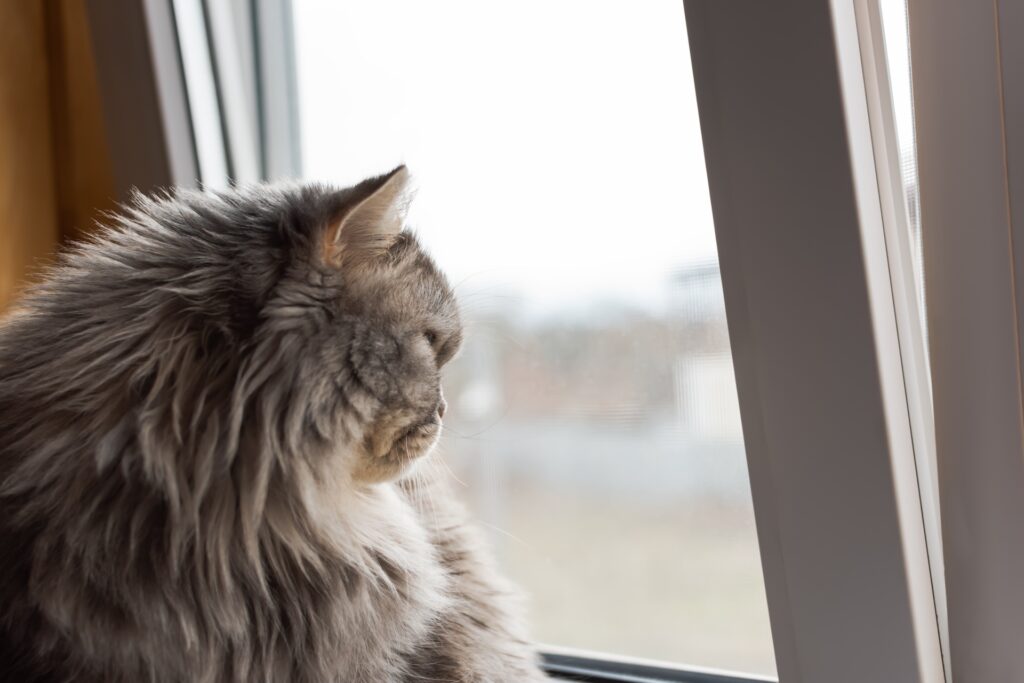Helping Cats with Separation Anxiety Tendencies: Preparing Your Cat for Changes in Caregiver Routine
 A fluffy Scottish cat looks out the window. The kitten sits on the windowsill and watches carefully. Orange eyes and a long mustache. A serious, thoughtful look. Portrait in profile. Copy space
A fluffy Scottish cat looks out the window. The kitten sits on the windowsill and watches carefully. Orange eyes and a long mustache. A serious, thoughtful look. Portrait in profile. Copy spaceHolidays, hospital stays or new jobs might mean a cat has to be left alone for longer periods or is unable to be with a member of the family with whom they are especially attached. Preparing a cat for these occasions can help them cope and may ward against the development of SA.
Preparing for Changes to a Caregiver’s Routine
- Create a calm environment (follow guide on creating a Refuge Room: https://petcourses.co.uk/free-resources/creating-a-refuge-room-for-cats).
- Follow steps 3 and 4 in the Preparing a Cat for Changes in Their Core Territory resource (https://petcourses.co.uk/free-resources/how-to-prepare-your-cat-for-environmental-changes).
- Introduce timed feeders so that regular small feeds can be dispensed throughout the day (in preparation for the times the cat is alone).
- Very gradually alter the timing of your interactions and other routines to match the new one.
- If the change involves spending less time at home, very gradually begin to reduce your interactions, ensuring that the cat has alternative activities to focus on.
- Begin mimicking the new routine e.g. leaving the house at the new time but returning earlier. Gradually increase the time the cat is alone.
- If the cat is an indoor only cat, consider access to a safe and secure outdoor space (e.g. a catio) for greater environmental enrichment and to relieve boredom. However, they must be introduced to this space gradually and well in advance of the changes.
- For cats that are going to be left for long periods, consider getting a cat sitter but make sure they have been introduced on a number of occasions. A stranger coming in with new scents might make matters worse!
- Cats can begin to predict routines and this can alert them to being left alone. Picking up car and door keys at certain set times can be the trigger for anxiety about being left alone. To prevent this happening randomly pick up keys but don’t always go out. Go to the door, stand outside and lock it but immediately come back in, start the car engine but don’t go anywhere. Varying routines in this way prevents the cat from predicting when they are going to be left.
- If a cat is particularly attached to one caregiver, encourage other members of the family to take on some of the cat’s care. Play and training can further enhance their relationship. These interactions should be provided in accordance with the cat’s unique needs and the principles of positive reinforcement.
Preventing Problems and Alleviating Stress
- Habituate kittens to periods of alone time during their socialisation period and beyond.
- Follow the ‘Five Pillars of a Healthy Feline Environment’ to create a safe and enriching home.
- Carry out a stress review to identify and address any potential stressors.
- Create a suitable environment and manage triggers to include:
- Install a post box outside the house if a letter box disturbs and startles a ‘home alone’ anxious cat.
- Microchip operated cat-flaps prevent despots entering the house.
- Provide interactive activity toys before going out and set automatic timed feeders to deliver small regular meals whilst they are left alone.
- Leave on the TV, radio or an audio book to create a sense of someone being around and as mental enrichment for cats that are responsive.
- Draw curtains when window cleaners and refuse collectors are due to call.
Other Notes
It should be noted that, when using timed-feeders, the cat must be introduced to them first. Use the principles of desensitisation (DS) and counterconditioning (CC) so that the sound of them opening does not cause alarm as this could be an additional source of fear and stress.
For cats that already show marked distress when being left it is recommended that you work with a suitably qualified and experienced feline behaviourist.